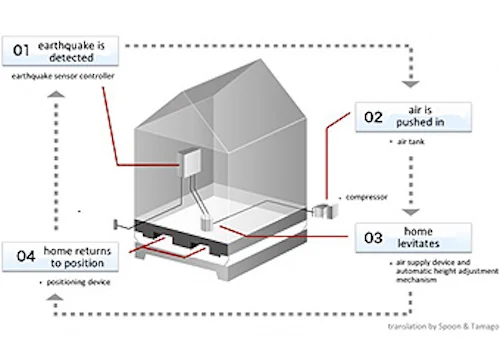Innovation is the key to survival in a world where natural disasters are a constant threat. Japan, a nation marred by frequent and powerful earthquakes, has taken a groundbreaking step towards securing its future with a technology that seems straight out of science fiction—levitating homes. This technology promises to safeguard Japanese homes from earthquakes and revolutionise the concept of disaster-proof housing.
The Magic of Air Danshin
At the heart of this innovation is Air Danshin, a company that has pioneered the development of a technology capable of raising homes off the ground during earthquakes. Since its inception in 2005, Air Danshin has refined a system that utilises compressed air to lift houses, effectively isolating them from ground tremors.
Imagine a typical Japanese home, indistinguishable from its neighbours, equipped with an extra foundation layer. Beneath this layer lies a sophisticated network of sensors and air compressors.
When these sensors detect seismic activity, they trigger the compressor, which pumps air rapidly between the house’s base and earthquake-proof foundation. The structure rises approximately 1.2 inches above the ground within seconds, creating a buffer against the quake’s shakes.
The efficacy of this technology was dramatically showcased during a 7.3-magnitude earthquake that struck Japan in February 2021. Air Danshin reported that all 30 homes equipped with their system emerged unscathed. This remarkable feat was further substantiated during the devastating 9.1-magnitude earthquake in 2011 when homes installed with this technology survived without a scratch.

Beyond Earthquakes: Flooding and Other Benefits
While primarily designed to combat seismic shocks, the benefits of levitating homes extend beyond earthquakes. These homes are also inherently resistant to flooding—a common aftermath of natural disasters, particularly in coastal areas. By not being anchored to the ground, these homes remain above floodwaters, further enhancing their utility in disaster-prone regions.
Despite its impressive capabilities, the levitation technology has its challenges. The cost remains prohibitively high, retrofitting a single home costing over three million yen (approximately $37,000). Furthermore, there are ongoing concerns about floating homes’ environmental and infrastructural impacts.
Nonetheless, the potential of levitating homes cannot be underestimated. With natural disasters becoming more frequent, these technologies are crucial in protecting lives and properties.
With continued development and broader adoption, levitating homes could become a cornerstone of urban planning in earthquake-prone regions worldwide, offering a buoyant beacon of hope to those facing the threats of the natural world.



























































